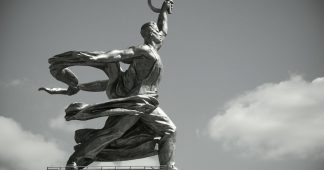By Hadas Thier
For weeks, a high-pitched panic about inflation has infused the mainstream media, most absurdly in CNN’s clip of a family struggling to keep up with the price of buying 12 gallons of milk per week (yes, 12).
Up until recently, Federal Reserve Chair Jerome Powell pushed back against this kind of narrative, arguing that rising prices were a short-term and transitory problem due to supply chain shocks from the pandemic that will eventually return to normal. But now the Fed has shifted course and is preparing to institute policies to “cool off the economy” — a euphemism for shrinking the money supply in order to drive down business investment and thus scale back job growth.
The definition of inflation is simple enough: an increase in the prices of goods and services. If prices rise quickly, and outpace wage growth, this can cause problems for working families — even those who don’t drink 12 gallons of milk per week. But the media narrative about rising inflation has conveniently left out several important points.
First, the prices of some of our biggest expenses — health care, housing, higher education to name a few — have been rising (often explosively so) for decades with little discussion or concern from the punditry. Health care costs are in fact the leading cause of bankruptcy in the country. Global food prices, too, have been rising because of the impact of climate change on crop yields. Easing these kinds of costs — through a nationalized health care system, investment in affordable housing, student debt relief and decarbonization — would go a much longer way toward improving working people’s finances than monetary policies to tighten economic growth.
Second, although it’s true that there has been a noticeable uptick in prices (measured by the annual change on the consumer price index) by 6.8 percent over the last year, this is still not very high by historical standards. The last time the United States experienced a serious inflationary crisis in the 1970s, the rate of inflation regularly hit between 11-13 percent. It’s also the case that measures of current price increases are skewed by a few sectors of the economy, most notably the energy sector.
A more useful measure to look at is a comparison of the rise of prices to the state of wages. If prices are going up faster than wages, then our relative purchasing power declines. But if wages keep pace with inflation, or even outpace inflation, then our purchasing power stays the same, or is strengthened. The reverse is also true. Thus, even though inflation rates have remained relatively low for much of the last few decades, wages have grown even less, meaning that purchasing power for working people declined despite low inflation rates.
Today, wages are finally rising. The New York Times recently reported that about 13 percent of workers have not seen pay increases this year and many retirees receive pensions that are constant. But it has been “middle- and high-income earners whose pay gains were least likely to have kept up with inflation. Over the 12 months that ended in September, those in the top quarter of earners experienced 2.7 percent gains in hourly earnings, compared with 4.8 percent for the lowest quarter of earners.” The combination of wage increases and COVID-19 relief checks have put more money in the pockets of the bottom half of earners than they had at the start of the pandemic.
Most importantly, the media spin has left out the elephant in the room. It is business owners who are the ones raising prices. They are currently setting record profits, so do they have to raise prices? The answer to this question ultimately reveals that inflation is a question of class politics — which class gains at whose expense — rather than technical monetary policies.
What Exactly Is Inflation, and Where Does It Come From?
Inflation is an increase in prices, generalized across the economy, i.e., not just the rise of one particular good but goods across wide swaths of the economy.
How does this happen? The classic explanation is that inflation occurs when too many dollars chase too few goods. That is, if demand for goods and services exceeds the world’s capacity to supply those goods and services, this creates an upward pressure on prices. Business owners can get away with charging more from consumers, who essentially bid against each other for limited supply.
Today, the rapid reopening of economies following lockdowns has created heightened demand for goods and services, far outpacing the rate at which supply chains have come online. The free market allows producers of items in short supply to “pick their price,” as anyone looking to buy a used car right now knows.
This can also lead to good old-fashioned price gouging. The oil industry, for instance, curtailed production at the height of the pandemic due to cratering demand for fuel. Now that demand is back up, Bloomberg News reports, “oil companies are keeping production flat while using profits to reward shareholders.” And although wholesale prices of oil have fallen somewhat, retail gas stations are still selling gas at high prices. “When wholesale prices decline rapidly, it provides a window for retail operators to sell at high prices for a few weeks before lowering prices,” oil storage broker Tank Tiger CEO Ernie Barsamian told Bloomberg. He noted that eventually gas prices will come down, but for now, many refiners and gas stations are enjoying the higher profits.
The other half of the inflationary equation is the role of increased workers’ wages. In a situation like today, where wages have begun to rise, this will feed an increased demand for goods, as working people have more money to spend. At the same time, higher wages also raise the cost of production for employers. If businesses pay higher wages to workers, the argument goes, this cuts into profit margins, leading capitalists to pass on their added costs to consumers.
Most mainstream economists assume that even if an external factor (a spike in oil prices due to geopolitical shifts, or supply chain chokeholds due to pandemic lockdowns) triggers the rise in prices, ultimately higher wages are the primary culprit of any sustained inflationary trends. Finally, mainstream economics draws a line between higher wages and low unemployment rates. A tight labor market, where workers are not easily replaced, gives workers more bargaining power to demand higher wages.
This line of argument was first championed by economist Milton Friedman, who stated that a ”natural rate of unemployment” exists below which inflation begins to take off. Friedman’s “monetarist” ideas took hold after the inflationary crisis of the 1970s, and ever since have been used as a battering ram against policies in which governments actively promote full employment or better jobs for workers.
In one sense, conservatives have a point. Karl Marx himself similarly argued that capitalism depends on unemployment — a “reserve army of labor” — to keep workers desperate enough to agree to whatever terms of work they can get. Unemployment, in other words, is a means to prevent wages from growing so far that they threaten profitability.
Class Conflict
The question that economic pundits conspicuously avoid is: What if instead of raising prices, businesses just made do with smaller profit margins? After all, U.S. corporations are currently making record profits, posting their fattest margins since 1950. Even at John Deere, the site of the highest-profile strike this year, Bloomberg News reports, “workers held out to get a 10% raise, yet the company is still expected to earn even more next year than the record profit it posted [in November].”
Workers don’t set prices, the bosses do. And they do so on the basis of maintaining the greatest possible profit margins. If workers’ wages go up but prices stay the same, this would simply mean that a greater share of profits went to workers rather than capitalists. System-wide, workers’ share of the economic pie (i.e., the “national income”) would increase. Falling unemployment, rising wages and increased social spending does not have to automatically translate into inflation of prices if we allow bosses’ profit margins and their share of the national income to decrease.
Even the dire rates of inflation in the 1970s, in the context of a strong labor movement “hurt capital more than it did workers, while neoliberal repression of workers’ power has kept inflation low from the 1980s onward,” sociologists Ho-fung Hung and Daniel Thompson have argued. The question of inflation is therefore a matter of class conflict over who gains at whose expense.
This is not to say that inflationary pulls aren’t a problem; if prices of common goods rise much faster than wages, or if the spikes in inflation are so high that businesses aren’t able to operate smoothly and fall into bankruptcy, laying off workers, this could have dire consequences. But the cures that are typically on hand are worse than the disease. Thus, in response to the crisis in the 1970s, the U.S. ruling class, led by President Ronald Reagan and Fed Chair Paul Volcker (though begun by President Jimmy Carter), was willing to induce a severe recession in order to stop inflation. The ensuing decades of neoliberalism created astronomical levels of class inequality.
But there are other tools to stop inflation, which do so in favor of workers. Price controls have been used in wartime throughout U.S. history, most significantly by President Franklin Delano Roosevelt’s administration. As political scientist Todd Tucker recently pointed out, FDR employed 160,000 federal employees in the Office of Price Administration to control prices “on goods from scrap steel to shoes to milk.” Even President Richard Nixon briefly implemented price controls.
Immediate reforms in the form of rent control, expanding Medicare, and allowing the government to negotiate lower drug prices are a good start to such policies, along with capping CEO pay and taxing the rich. Other reforms like investment into public housing and public education also indirectly cap prices.
Ultimately, a left economic agenda must push back against the inflation panic to maintain demands for higher wages and increased social spending, while guarding against real inflation through price controls and policies that protect working people’s pockets.
Published at truthout.org
We remind our readers that publication of articles on our site does not mean that we agree with what is written. Our policy is to publish anything which we consider of interest, so as to assist our readers in forming their opinions. Sometimes we even publish articles with which we totally disagree, since we believe it is important for our readers to be informed on as wide a spectrum of views as possible.











